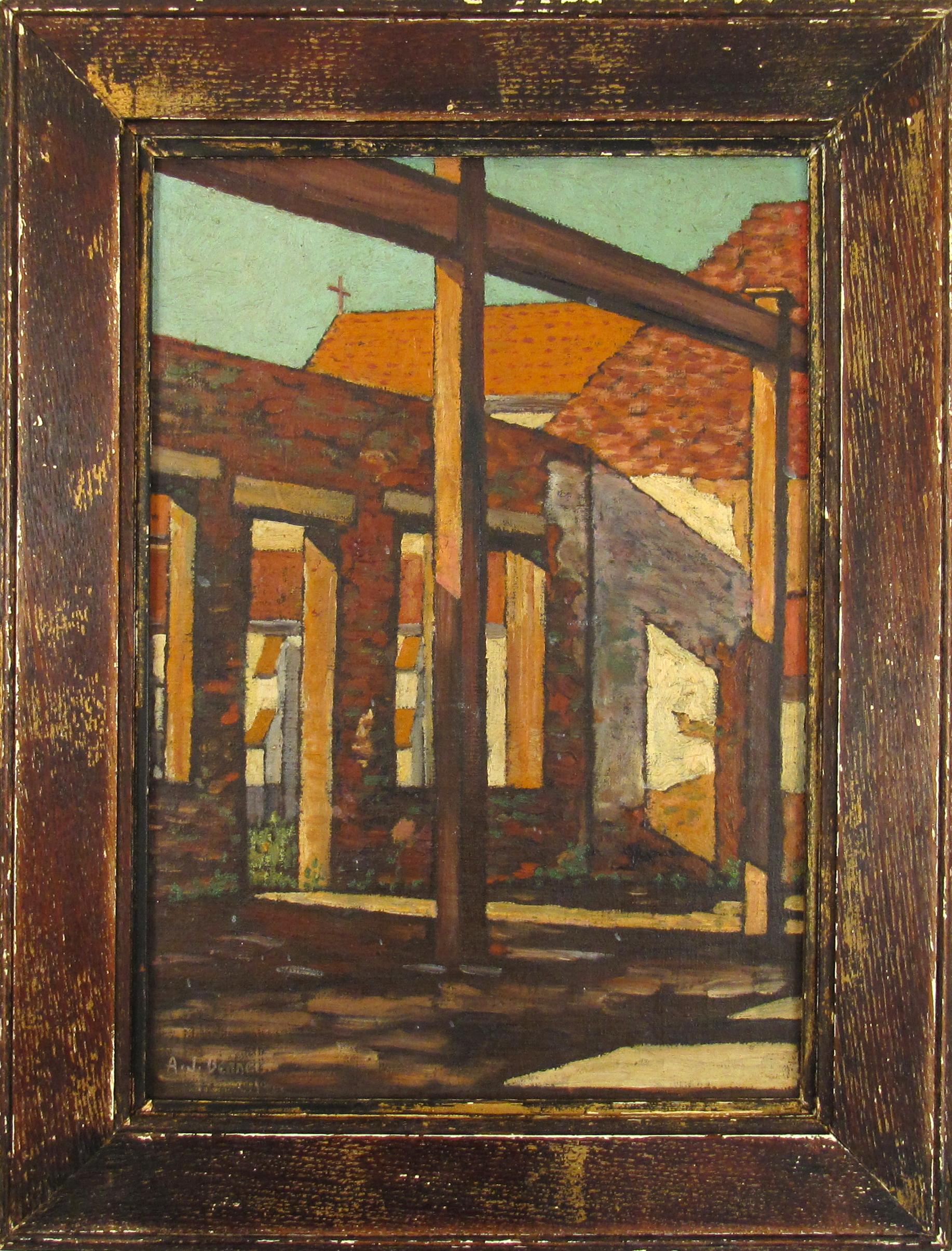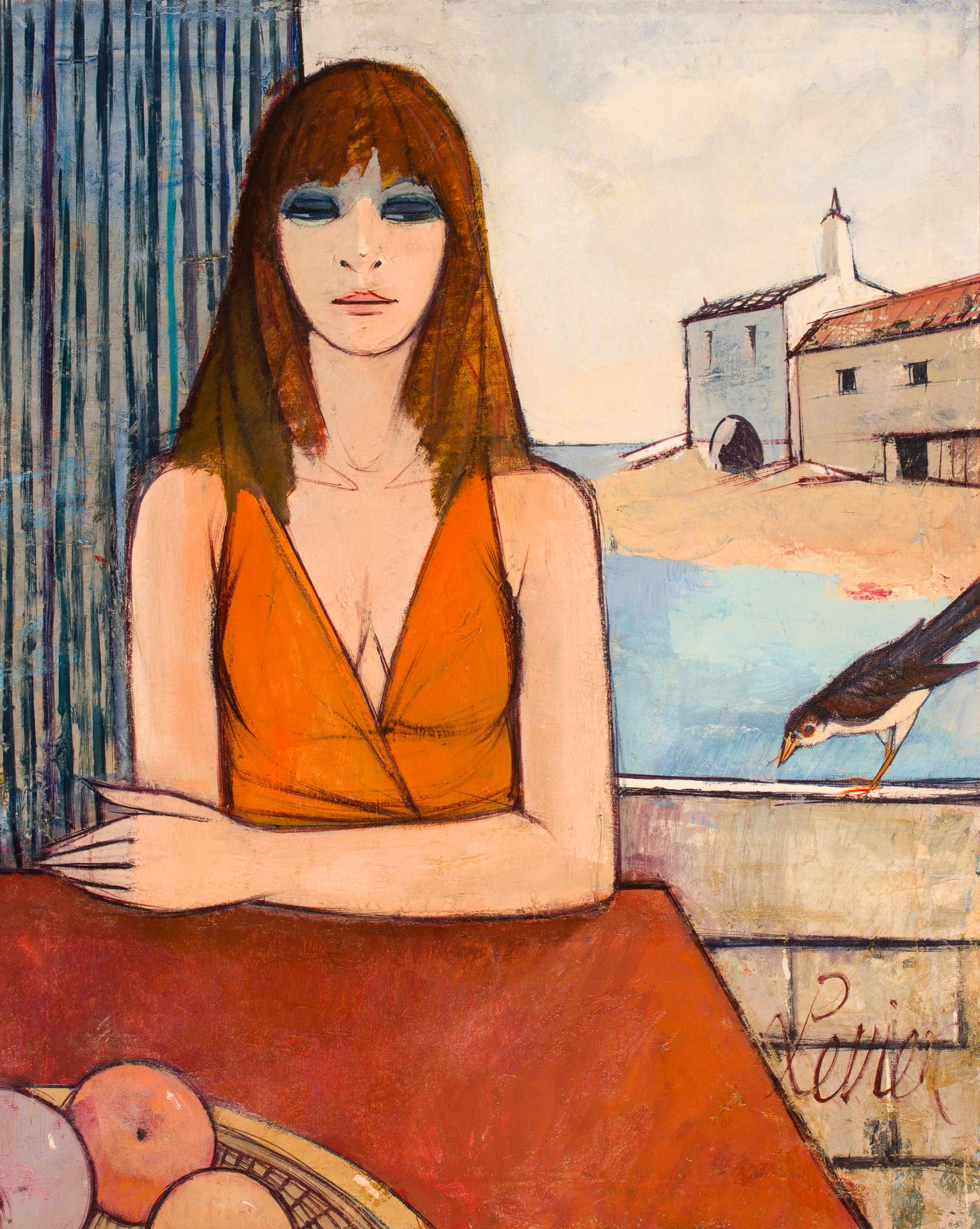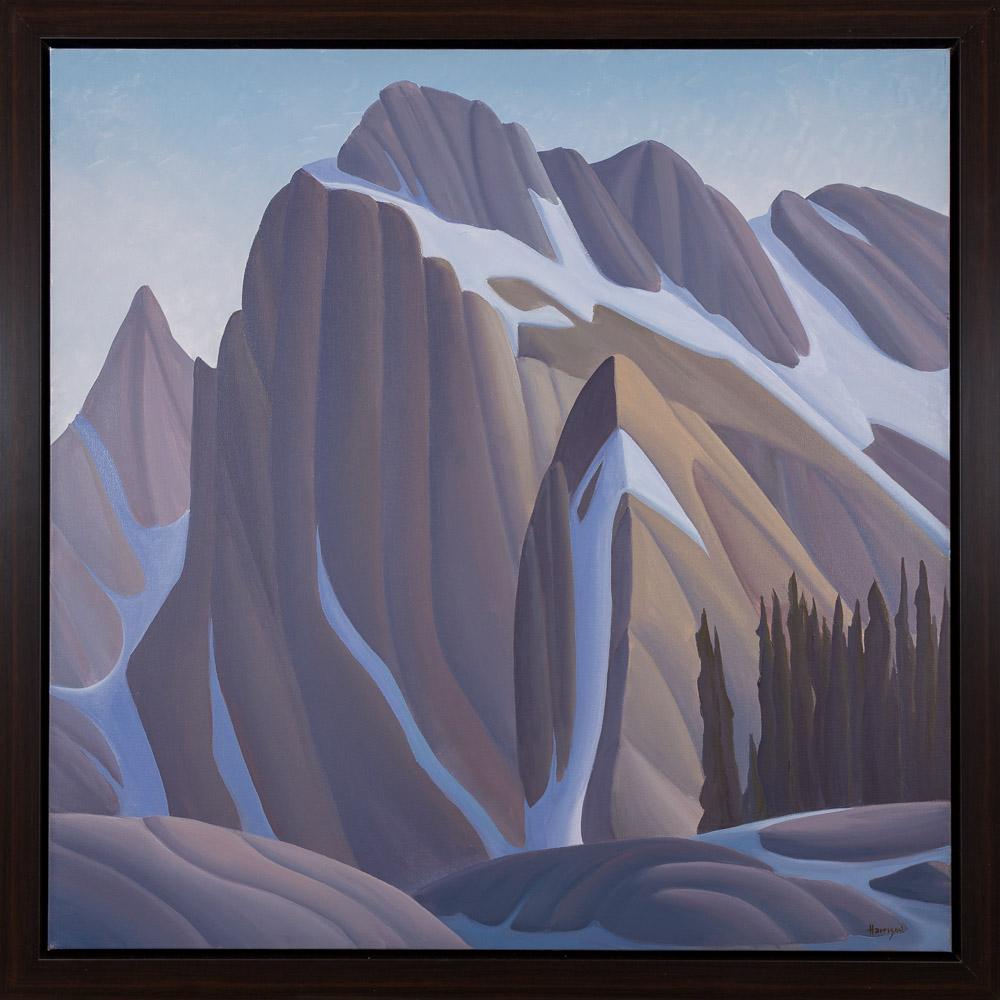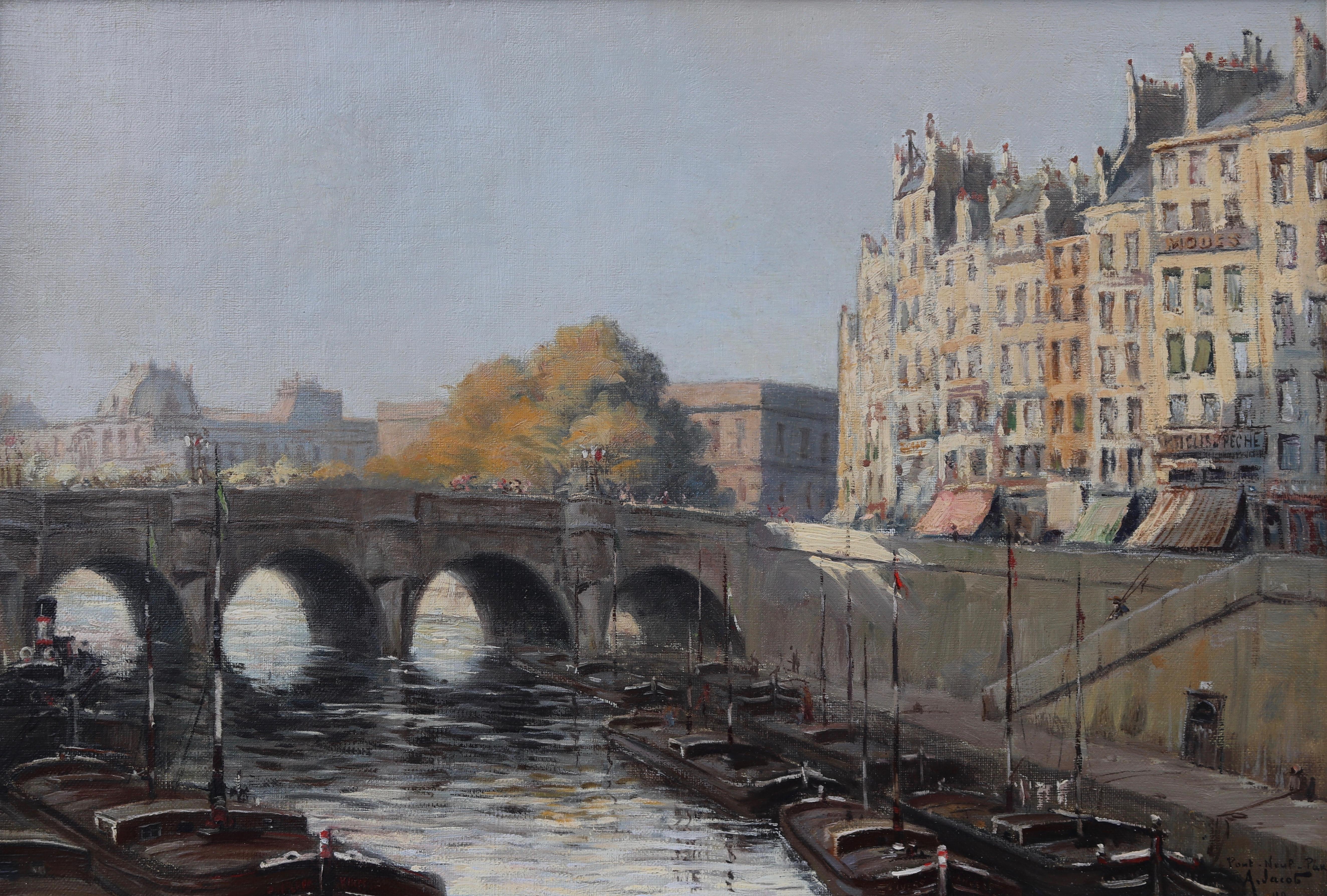Antoine Blanchard"Boulevard de la Madeleine, " Antoine Blanchard, Paris French Street Scene
About the Item
- Creator:Antoine Blanchard (1910-1988, French)
- Dimensions:Height: 21 in (53.34 cm)Width: 26 in (66.04 cm)
- Medium:
- Movement & Style:
- Period:
- Condition:
- Gallery Location:New York, NY
- Reference Number:1stDibs: LU184129924442
Antoine Blanchard
Antoine Blanchard was born in France on November 15, 1910, in a small village near the banks of the Loire. He was the eldest of three children, and his father, a carver, managed a small carpentry and furniture shop. Blanchard would watch his father hand carve the furniture, and he began to display an artistic flair early in life — in an effort to promote this talent, his parents sent him to Blois for drawing lessons. He continued his training in Rennes at the Ecole des Beaux-Arts where he studied sculpture and drawing. Upon completion of his studies, he was awarded the school’s highest award: Le Prix du Ministre.
By 1932 Blanchard left Rennes and traveled to Paris to study. He enrolled at the Ecole des Beaux-Arts and after a few years entered the competition for the Prix de Rome. It was in Paris that he developed a love for the city and its street life. In 1939 Blanchard married a young woman he met in Paris, and in September of that year war broke out and he was called up for service. It was not until 1942 that he would return to his art.
Blanchard’s daughter Nicole was born in 1944 — she too would follow in the family tradition and after the birth of her two daughters, she became an artist working under the name A. Champeau. It was also around this time that Blanchard's father passed away, and he was compelled to return to his hometown and run the family business — giving him little time to paint.
The artist’s second daughter, Evelyn, was born in 1947, and by 1948, he had given control of the family business to his younger brother and returned to Paris to paint. Contemporary life in Paris had changed, and Blanchard longed for the bygone days. He began to research the Belle Époque period in Paris — reading and studying all the material on the period he could find.
Many of the subjects and scenes Blanchard portrayed were taken from images he collected of Paris during the 1890s, and he would often work on paintings for days or months before he finally felt they were complete. A.P. Larde comments in his book Antoine Blanchard, His Life His Work that he had always spent much time on his work — this explains why his production has always been rather limited, unlike the hurried and multiple proliferations of some modern artists. Delicate touches of luminous and shimmering tones produce a marvelous impression of harmony, brightness and light. Alternate shadings and lights, sensitive and mellow blending allow the artist to attain a hardly-ever reached degree of grace, of radiant and glimmering freshness.
Larde writes that Blanchard’s works are, first of all, a marvelous invitation to an ideal walk through old Paris, so different from that of today. Although a large number of historical monuments remain, today's Paris has little in common with Paris at the turn of the century; the scenery may be almost the same, but daily life as its characters has totally changed; the customs have been entirely transformed. In his landscape paintings, Blanchard invites us to relive this period by showing us pleasant strolls along embankments, squares and boulevards at a period in Parisian life when time did not count, when one had all one's time to idle, to stroll along the streets, to window-shop, to walk quietly along the boulevards or spend the afternoon in a sidewalk café.
Like his contemporary, Édouard Cortès, Blanchard devoted his artistic career to the depiction of Paris through all its daily and seasonal changes. But he was not an imitator of Cortès, but rather depicted the life of Paris at the turn of the century from his own point of view and with his own unique style. Blanchard always used small strokes, with a delicate, enveloping and mellow treatment; the slight haziness, which is a characteristic of his work, in many ways recalls the great masters of the Impressionist period.
Whether it was l'Arc de Triomphe, la Madeleine, Café de la Paix, Notre Dame or the dozens of other historical monuments and buildings of Paris, Blanchard’s focus was on the daily life of Paris at the turn of the century. His work became highly sought after, and collectors from around the world vied to acquire his new works. Today he is considered one of the leading exponents of the School of Paris painters.
Find original Antoine Blanchard paintings on 1stDibs.
(Biography provided by Lincoln Glenn)
- ShippingRetrieving quote...Ships From: New York, NY
- Return PolicyA return for this item may be initiated within 3 days of delivery.
- "Late Summer, " Carl Wuermer, Pointilism, American Impressionism August LandscapeBy Carl WuermerLocated in New York, NYCarl Wuermer (1900 - 1981) Late Summer, 1924 Oil on canvas 26 x 28 inches Signed and dated lower right Provenance: McColl Fine Art, North Carolina Known for serene, realistic lands...Category
1920s Pointillist Landscape Paintings
MaterialsCanvas, Oil
- "Berkshire Hills, Massachusetts, " Paul Greene, Bright Large New England SceneLocated in New York, NYPaul Greene (1925 - 2020) Berkshire Hills Landscape, Massachusetts Oil on canvas 50 x 97 inches Signed lower right Provenance: Private Collection, Great Barrington...Category
Late 20th Century Fauvist Landscape Paintings
MaterialsCanvas, Oil, Acrylic
- "Prospect Park, Brooklyn, " Nathan Hoffman, New York City Impressionist LandscapeLocated in New York, NYBorn in Russia, the son of Friede (1878 – 1956) and Benjamin Hoffman (1878 – a. 1942). Benjamin was a dealer in mineral and seltzer water and the family resided on Snediker Avenue in Brooklyn, New York, just down the streetfrom the home where George Gershwin (1898 – 1937) was born. This area of Brooklyn, known as Brownsville, “witnessed the development of one of the largest communities of Eastern European Jewish immigrants during the last decade of the 19th century and the first two decades of the 20 th century.” Today, little remains of this once thriving Jewish section of Brooklyn, which today houses many commercial and repair businesses. Hoffman studied at the Art Students League of New York, the National Academy of Design and in the art program at Cooper Union. His work at the National Academy received praise, and in 1921 he was awarded the 2nd prize and an honorable mention from the John Armstrong Chaloner Paris Prize Foundation at the National Academy, which allowed the recipient to study in Paris, France for as long as five years. The following year he was awarded the 1 st prize in the competition (with The Reform Advocate running the headline “Young Jew Wins Art Prize”) as well as the Suydam Bronze Medal for his achievements in the Academy’s Men’s Night Class. In 1923 he was residing in Long Branch, New Jersey, when he was awarded 4th place in the Chaloner competition. Early on, Hoffman exhibited his work throughout the city, including in 1925 with the recently organized Society of Independent Artists. He also received several solo exhibitions during the first part of his career, including one at Ferargil Galleries in 1929. In the spring of 1930 a solo exhibition of his portraits, including paintings and drawings, was held at at Babcock Galleries, where a reviewer noted: “Portraiture is obviously Mr. Hoffman’s specialty… his best work is characterized by a sensitive appreciation of character set down in a vigorous decisive statement. Later that same year, in August, he participated in Babcock’s summer exhibition where reviewer Jerome Klein, writing for The Baltimore Sun, felt Hoffman’s and other artists work was already becoming old fashioned, remarking “…if an effort toward accomplishment is to be made, it must be in the language of today. It is for that reason that such contemporaries as Eugene Higgins and Nathan Hoffman, in this show, seem artists of a bygone era…” The onset of the Great Depression appears to have slowed his success, as was the case for many up-and-coming artists. By 1939 Hoffman had become a gallerist in addition to being a painter, operating the collective exhibition space “Sutton Gallery,” which was originally located at 358 East 57th Street. There Hoffman exhibited his own works as well as those created by other prominent New York artists including David Burliuk (1882 – 1967), Charles C. Curran (1861 – 1942), Louis Eilshemius (1864 – 1941), Ann Goldthwaite (1869 – 1944), Maurice Kish (1895 – 1987), Lawrence Lebduska (1894 – 1966), Bradford Perin and Ellis Wilson...Category
1940s Post-Impressionist Landscape Paintings
MaterialsOil, Board
- "Gondolas at the Dock, Venice, Italy" Louis Wolchonok, Boats in the Harbor SceneBy Louis WolchonokLocated in New York, NYLouis Wolchonok (1898 - 1973) Gondolas at the Dock, Venice, Italy, 1928 Watercolor on paper Sight 18 x 23 1/2 inches Signed and dated lower right Louis Wolchonok was an author of ar...Category
1920s Post-Impressionist Landscape Drawings and Watercolors
MaterialsPaper, Watercolor
- "New York Yankees World Series Celebration, " Kamil Kubik Baseball Street ParadeBy Kamil KubikLocated in New York, NYKamil Kubik (1930 - 2011) The New York Yankees 1998 Baseball World Series Celebration, 1998 Pastel on paper Sight 26 x 19 1/2 inches Provenance: The artist's estate The 1998 New York Yankees were one of the best baseball teams ever, comprising players such as Jorge Posada, Tino Martinez, Chuck Knoblauch, Scott Brosius, Derek Jeter...Category
1990s Post-Impressionist Landscape Paintings
MaterialsPaper, Oil Pastel
- "Pastoral Landscape, " William Hart, Hudson River School, Cloudy View with CowsBy William HartLocated in New York, NYWilliam Hart (1823 - 1894) Pastoral Landscape, 1877 Oil on canvas 9 1/2 x 14 1/2 inches Signed and dated lower left Born in Paisley, Scotland, William Ha...Category
1870s Hudson River School Landscape Paintings
MaterialsCanvas, Oil
- A. J. Bennett - Light and Shade - Post Impressionist Painting, South Africa 1919Located in Meinisberg, CHA. J. Bennett (South African, fl. Early 20th century) Light and Shade • Oil on canvas artist board ca. 42.5 x 29.5 cm • Later frame ca. 53.5 x 41 cm Worldwide shipping is complime...Category
1910s Post-Impressionist Figurative Paintings
MaterialsCanvas, Oil, Board
- PrintempsBy Charles LevierLocated in Costa Mesa, CAA beautiful woman sits at an open window, gazing down at a small bird who has landed nearby in this serene portrait by Charles Levier. Warm orange tones are played off their complements in shades of blue, the artist utilizing several different layers of oils to create a subtle and relaxed view of a spring day near the sea. Beyond the window a small chapel sits on a peninsula, surrounded tranquil blue waters. This work, like many of Levier's, belongs to the French figurative movement of the Glorious Thirty (Les Trente Glorieuses) - the golden period of thirty years after WWII which were a time of great hope and prosperity in France. Inspired by Hollywood cinema, Charles Levier sought harmony in composition and purity of color and form. His said that his creations represented "a light and delicate world, of dark and subtle shades and colors." Levier worked in a somewhat abstracted, cubist style. Additionally he often employed the French technique of "cloisonnism" (after the French for "partition"), a style of post-Impressionist painting with bold and flat forms separated by dark contours, also seen in this work. The term was coined by critic Edouard Dujardin on the occasion of the Salon des Indépendants, in March 1888 and was commonly used by artists like Émile Bernard, Louis Anquetin, Paul...Category
Mid-20th Century Post-Impressionist Figurative Paintings
MaterialsCanvas, Oil
- Mount Whitney California Original Ken Harrison Contemporary Oil LandscapeLocated in Whitefish, MT"Mount Whitney, California" by Kenneth Harrison. Oil on Canvas, 36" x 36", 40" x 40" framed in a modern black floater. “My goal is to capture a peaceful relaxing moment on canvas” ...Category
21st Century and Contemporary Post-Impressionist Landscape Paintings
MaterialsCanvas, Oil
- Le Pont Neuf à ParisBy Alexandre Louis JacobLocated in London, GBAlexandre Jacobs tranquil and subtle landscapes show a masterful evocation of light, atmosphere and colour, transporting the viewer into the peaceful countryside of rural France. He ...Category
20th Century Post-Impressionist Landscape Paintings
MaterialsCanvas, Oil
- Bords de l'Eure pres de CocherelBy Georges Charles RobinLocated in London, GBRecognised as one of the best post-impressionist artists, Robin's skill and complete command of his palette set him aside from his contemporaries. Combining his deft and delicate touch with vigorous, dramatic brush strokes and palette knife work, he produced exceptional paintings. Enthralled by the enchanting river valleys of rural France that flowed through the luxuriant countryside and rolling fields, Robin's paintings perfectly capture rustic and typical French life. Feted by the French artistic establishment and his many patrons during his lifetime, the multitude of awards that Robin garnered for his work illustrates the acclaim in which he was held. Gladwell Patterson...Category
20th Century Post-Impressionist Landscape Paintings
MaterialsCanvas, Oil
- Haystack with Resting FiguresBy John Maclauchlan MilneLocated in Hillsborough, NCScottish artist John Maclauchlan Milne, RSA, (1885-1957) is a contemporary of Scottish Colourists Peploe, Fergusson, Cadell and Hunter. Like the...Category
1920s Post-Impressionist Landscape Paintings
MaterialsCanvas, Oil






